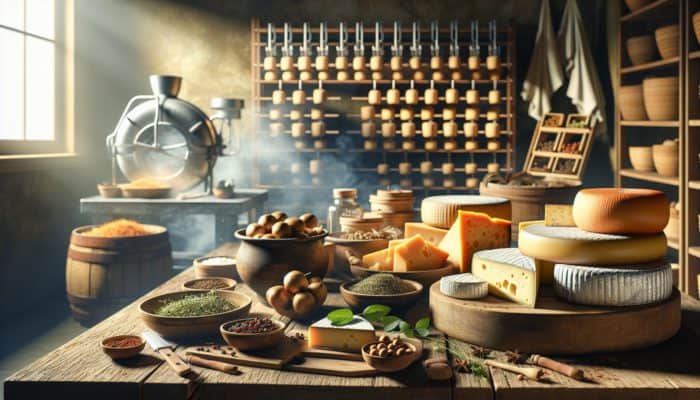Master the Art of Selecting the Ideal Cheese for an Unforgettable Smoking Experience
Discover the Best Cheese Varieties for Elevating Your Smoking Journey

Choosing the perfect cheese is crucial for crafting a delightful and successful smoking experience that tantalizes the taste buds. Hard cheeses such as cheddar, gouda, and gruyère stand out as exceptional options due to their low moisture content and sturdy texture, which helps them maintain their shape during the smoking process. The dense consistency of these cheeses allows them to absorb the rich, smoky flavors effectively while ensuring they do not melt away. In contrast, soft cheeses like brie or cream cheese are typically less suitable, as they tend to become gooey and lose their structure when subjected to heat, often leading to a less enjoyable smoking experience.
As you explore the diverse world of cheese, it’s essential to pay attention to their unique flavor profiles. Aged cheeses often provide a more pronounced and complex baseline for smoking, allowing the smoke to enhance and elevate their natural flavors. For instance, an aged cheddar may reveal delicious nutty undertones, while smoked gouda can develop a rich, caramel-like sweetness. The interplay between the inherent flavors of the cheese and the smoky infusion is vital in determining the quality of the final product, making this a rewarding endeavor for every culinary enthusiast eager to elevate their cooking skills.
Where to Source Premium Quality Cheese Across the United States?
Finding top-notch cheese throughout the United States can be an enjoyable adventure, simply by exploring local cheese shops and specialty markets. Numerous artisanal cheesemakers across the country are devoted to crafting unique cheeses that are perfectly tailored for smoking. Farmers' markets are also excellent venues for discovering local cheese varieties while supporting small-scale producers. Regions renowned for their exceptional dairy products, such as Wisconsin and California, should be on your radar. If you're in these areas, take the time to explore their diverse selections to uncover the best cheese options available.
Moreover, seek out cheese shops that prioritize quality over quantity. These establishments usually curate a carefully selected assortment of cheeses that have been aged and crafted with precision, making them ideal candidates for smoking. Don’t hesitate to ask for recommendations; the knowledgeable staff can offer invaluable insights into which cheeses will best align with your specific smoking preferences and enhance your overall culinary experience.
How to Assess the Quality of Your Cheese Choices?
Evaluating the quality of cheese involves considering several critical indicators. Begin by examining the texture; high-quality cheese should feel firm and consistent throughout, which indicates proper aging and meticulous care. Next, focus on the aroma; the cheese should emit a fresh, inviting scent without any off-putting odors. Finally, the taste is paramount—sampling a small piece will help you gauge its flavor profile effectively and assess its suitability for your smoking project.
- Firm texture without cracks
- Inviting, fresh aroma
- Rich, complex flavor
- No off flavors or rancid notes
- Even color without discoloration
- Proper aging indicated by slight moisture on the rind
- Packaging that keeps the cheese protected and fresh
These indicators not only assist you in selecting the finest cheese for smoking but also enrich your overall culinary journey as you delve into the diverse world of flavors and textures that cheese has to offer.
Your Complete Guide to Preparing Cheese for the Smoker

Effective Techniques for Cutting and Shaping Cheese for Maximum Smoking Benefits
Proper preparation is vital for successfully smoking cheese. Begin by cutting the cheese into uniform pieces; this step ensures that each piece receives even exposure to smoke. Aim for blocks or slices that are approximately 1 inch thick, as this thickness promotes optimal smoke absorption while preserving the structural integrity of the cheese. Thin shreds should be avoided, as they are prone to melting quickly under the smoker’s heat, ultimately negating the purpose of smoking.
Consider the following cutting techniques to achieve the best results:
- Utilize a sharp cheese knife for clean, precise cuts
- Cut into blocks for a traditional, appealing presentation
- Opt for slices if you prefer smaller, convenient pieces
- Experiment with various shapes for enhanced visual appeal
- Maintain consistent thickness to ensure uniform smoking
By dedicating time to cut and shape your cheese correctly, you establish a solid foundation for a fantastic smoking outcome that showcases the rich flavors and textures of your selected cheese.
What is the Best Acclimation Time for Cheese Before Smoking?
Allowing cheese to acclimate to room temperature is a critical step in the smoking process. Let your cheese sit at room temperature for about 30 minutes prior to placing it in the smoker. This practice allows the cheese to warm slightly, enhancing its ability to absorb smoke effectively. A significant temperature difference between the cheese and the smoker can lead to uneven smoke penetration, resulting in less desirable outcomes.
This pre-smoking phase not only aids in flavor absorption but also minimizes the risk of melting. Cold cheese can sweat when introduced to warmer smoke, causing it to lose its form. The goal is to strike a balance between maintaining the cheese's structural integrity and enhancing its flavor with the smoke infusion, ensuring a delightful end product.
Brining and Seasoning Techniques to Elevate Your Smoked Cheese Experience

Brining and seasoning can significantly enhance the flavor profile of your smoked cheese. By soaking the cheese in a brine solution, you can infuse it with additional flavors while simultaneously improving its moisture retention, which is beneficial during the smoking process. A simple brine can be created using water, salt, and your choice of herbs or spices, dramatically elevating the overall taste experience.
Dry rubs are another effective technique; applying a blend of spices directly onto the cheese can create a flavorful crust that beautifully complements the smoky essence. Consider experimenting with a variety of herbs such as rosemary, thyme, or paprika, customizing the cheese according to your individual preferences and enhancing its flavor profile.
Keep in mind that the key is to experiment and discover what works best for your palate. A well-seasoned cheese will provide a depth of flavor that enriches your smoking experience, transforming the final product into a delightful culinary treat that excites the senses.
Insider Tips for Successfully Smoking Cheese Without Melting
Determining the Ideal Temperature Range for Smoking Cheese
Keeping the temperature within the appropriate range is crucial for successful cheese smoking. The ideal smoking temperature lies between 70-90°F. Staying within this range allows the cheese to absorb the smoky flavor while avoiding melting. A reliable thermometer is essential for accurately monitoring your smoker's internal temperature to ensure it remains within this optimal range.
In practical terms, many experienced cheese smokers have achieved success at temperatures closer to 80°F. At this temperature, the cheese is warm enough to accept the smoke flavor without succumbing to melting. Remember that external factors, such as outdoor air temperature, can impact your smoker's internal environment, so adjustments may be necessary to maintain the desired temperature throughout the smoking process.
How to Effectively Manage Humidity Levels in Your Smoker?
Controlling humidity is essential to prevent cheese from sweating and melting during the smoking process. Low humidity levels help maintain the cheese’s structure and quality. To achieve this, opt for a smoker with adequate ventilation that promotes airflow. If your smoker lacks sufficient ventilation, consider adding a small fan to circulate air and effectively reduce moisture levels.
Regularly monitor the conditions inside the smoker. If you observe excessive moisture accumulation, adjust the airflow or slightly open the smoker’s vents to encourage evaporation. A dry environment is crucial for optimal smoke absorption and preserving the integrity of the cheese throughout the smoking process, ensuring a delightful final product.
Choosing the Right Wood for Flavorful Cheese Smoking
The type of wood you select for your smoking endeavors can profoundly influence the flavor profile of your cheese. Different woods impart unique flavors; for instance, applewood and cherry wood are popular choices due to their mild, sweet smoke, which harmonizes beautifully with the natural flavors of various cheese varieties.
When experimenting with different wood types, consider the intensity of the smoke flavor and its interaction with the cheese. For example, hickory or mesquite can produce a much stronger flavor that might overwhelm lighter cheeses but could pair exceptionally well with robust options like aged cheddar. Don’t hesitate to mix different wood types to discover new flavor profiles that enhance your smoked cheese experience.
Setting Up Your Smoker for Maximum Cheese Smoking Potential
Identifying the Best Smokers for Cheese Smoking
When it comes to smoking cheese, the type of smoker you choose can greatly influence the final result. Cold smokers and electric smokers are particularly suitable as they maintain the lower temperatures necessary for effective cheese smoking. Cold smokers are specifically designed to keep temperatures low, allowing for a gentle infusion of smoke without exposing the cheese to excessive heat, which is essential for a successful smoking outcome.
If you’re considering investing in a smoker dedicated to cheese smoking, look for models designed specifically for low-temperature applications. Some brands offer dedicated cold smoking attachments compatible with traditional smokers, providing versatility for smoking a variety of foods, including cheese, and ensuring a delightful culinary experience.
How to Modify a Regular Smoker for Cheese Smoking?
If you already own a conventional smoker and want to adapt it for cheese smoking, there are several effective changes you can implement. One popular method is to utilize a cold smoke generator, which produces smoke at lower temperatures without applying direct heat. This device can be attached to your smoker, creating an ideal environment for cheese smoking without risking melting.
Another widely used technique is the snake method with charcoal. By arranging lit charcoal in a “snake” pattern around the perimeter of the smoker, you can effectively control the temperature and burn time. This approach allows for a prolonged burn at lower temperatures, making it well-suited for smoking cheese without compromising flavor or melting.
Essential Safety Measures When Using Smokers
Safety should always be paramount when utilizing smokers. Begin by ensuring proper ventilation in your smoking area. Adequate airflow is crucial to prevent the buildup of carbon monoxide and other harmful gases. Follow the manufacturer's guidelines for setup and operation, ensuring that your smoker is located away from any flammable materials, such as dry leaves or wooden structures, to mitigate safety risks.
Regularly monitor the smoker while in use to maintain stability and safety. It’s wise to keep a fire extinguisher readily accessible, just in case of emergencies. By taking these precautions, you can enjoy a worry-free and successful smoking experience that yields delicious results.
The Comprehensive Smoking Process: A Detailed Step-by-Step Guide
Determining the Optimal Duration for Smoking Cheese for Best Results
The time required for smoking cheese can vary based on the desired flavor intensity, typically ranging from 2 to 6 hours. A shorter smoking duration will yield a milder flavor, while extended periods can significantly enhance the smoky taste. Throughout this process, it’s essential to keep a close eye on the cheese to avoid over-smoking, which could lead to an undesirable bitter flavor profile that detracts from the overall experience.
For beginners, starting with a 2-hour smoking session is advisable, allowing you to gauge how much flavor the cheese absorbs. From this point, you can adjust the smoking time based on your personal preferences and the specific characteristics of the cheese you are using. Use this opportunity to experiment with various cheeses and smoking durations to discover your ideal flavor balance and create unique culinary delights.
Monitoring and Adjusting Conditions During the Smoking Process
While smoking cheese, consistent monitoring is crucial for achieving the best results. Keep track of both the temperature and smoke levels throughout the smoking process. If you notice the temperature rising above 90°F, make the necessary adjustments to your smoker or add ice packs to maintain a cooler environment, thus ensuring optimal smoking conditions.
Additionally, pay attention to the smoke levels; excessive smoke can overpower the cheese's natural flavors. If necessary, reduce the quantity of wood or modify the airflow to regulate the smoke output. Frequent checks will ensure that your cheese receives the ideal conditions for effective smoking, resulting in a delightful and perfectly smoked product.
How to Determine When Your Cheese is Ready to Savor?
Identifying when your cheese is ready for enjoyment involves several sensory cues. The cheese should feel firm yet slightly pliable to the touch, indicating that it has absorbed enough smoke. It will also emit a noticeable smoky aroma, signaling that it has taken on the desired flavor. If you’re uncertain, you can always cut a small piece to taste and assess its quality, ensuring you achieve the perfect balance of flavors.
Striking a balance between achieving the right flavor and avoiding over-smoking is crucial for a successful outcome. The cheese is ready when it has absorbed the preferred amount of smoke while still maintaining its original texture and flavor profile, ensuring a delightful tasting experience that showcases the rich flavors of your smoked cheese.
Best Practices for Storing Smoked Cheese to Preserve Quality
After the smoking process, proper storage is vital to maintain the flavor and quality of your cheese. Wrap the smoked cheese in wax paper or parchment paper to allow it to breathe while still protecting it from drying out. Following the wrapping, place the cheese in an airtight container in the refrigerator to preserve its freshness and flavor, ensuring that each bite remains as delightful as the first.
Avoid using plastic wrap directly on the cheese, as this can trap moisture and lead to a soggy texture that detracts from the overall quality. Implementing proper storage practices will ensure that your smoked cheese retains its delightful flavor and does not spoil prematurely, allowing you to enjoy it longer and incorporate it into your culinary creations.
Research-Backed Benefits of Smoking Cheese Without Melting
Enhancing Flavor Profiles Through the Smoking Process
Smoking cheese adds remarkable depth and complexity to its flavor profile. The smoking process infuses the cheese with rich, savory notes that can accentuate its natural characteristics. Various studies have shown that smoke can significantly enhance cheese flavors, making it a more versatile ingredient in culinary applications and elevating the overall dining experience.
This flavor enhancement can transform basic cheese into a gourmet ingredient. Smoked cheese can be used in a wide array of dishes, from simple cheeseburgers to sophisticated cheese platters, enhancing the overall dining experience and offering a delightful twist on traditional recipes. The smoky flavor also pairs beautifully with various wines, creating an unparalleled tasting journey that excites the palate and invites culinary exploration.
What Health Benefits Can You Expect from Enjoying Smoked Cheese?
Smoked cheese retains many of the beneficial properties found in regular cheese. It serves as a good source of protein and calcium, both of which are essential for maintaining strong bones and muscles. Furthermore, some studies suggest that smoking may help preserve certain nutrients within the cheese, although moderation is key due to the added sodium from the smoking process, which should be considered within the context of a balanced diet.
While enjoying smoked cheese, consider balancing it within a healthy diet. Pairing it with fresh fruits, nuts, or whole-grain crackers can create a nutritious and satisfying snack or appetizer that complements your overall dietary goals while indulging in the delightful flavors of smoked cheese.
Extending the Shelf Life of Smoked Cheese
One practical benefit of smoking cheese is its ability to extend shelf life. The smoking process acts as a natural preservative, protecting the cheese against spoilage. This is particularly advantageous for hard cheeses, which can maintain quality for significantly longer periods when smoked, allowing you to enjoy them over time without compromising flavor or texture.
When stored correctly, smoked cheese can retain its quality for weeks, if not months. This makes it an excellent option for those who enjoy making cheese in bulk or wish to prepare snacks in advance for gatherings. The preservation quality of smoked cheese also makes it a popular choice for charcuterie boards, ensuring that it remains fresh and delicious throughout your culinary endeavors.
Best Practices for Storing and Aging Your Smoked Cheese
Key Techniques for Successful Storage
To maintain the quality of your smoked cheese, employing proper storage techniques is crucial. The best method is to keep the cheese in a cool, dark place, ideally within a vacuum-sealed bag or tightly wrapped in wax paper. This approach helps prevent the cheese from drying out or absorbing unwanted flavors from other foods in the refrigerator, preserving its unique taste and texture for future enjoyment.
When storing in the refrigerator, ensure that the cheese is kept away from strong-smelling items like fish or onions, which can compromise its flavor profile. Regularly check your stored cheese for any signs of spoilage or mold, and act swiftly to address any issues that arise to ensure optimal quality and enjoyment of your smoked cheese.
How Long Can Smoked Cheese Be Aged for Optimal Flavor?
The aging process for smoked cheese can vary significantly based on the type of cheese and the flavor profile you desire. Generally, smoked cheese can be aged anywhere from several months to a year. During this time, its flavors will continue to develop, creating a more complex and nuanced cheese experience that delights the palate.
As you age your smoked cheese, it’s important to monitor it regularly. The optimal aging conditions—typically around 50-55°F with humidity levels of 80-85%—are crucial for achieving the best flavor development. Keeping a close watch on the aging process will help you achieve the ideal balance of flavors and textures, resulting in a cheese that’s both delicious and satisfying.
Tips for Enhancing Flavor During the Aging Process
To enhance the flavor of your smoked cheese during the aging process, create a controlled environment that encourages flavor development. The right temperature and humidity levels are essential; utilizing a cheese cave or a dedicated refrigerator can help maintain these conditions consistently, ensuring your cheese ages properly.
Experimenting with different aging durations will allow you to discover your ideal flavor profile. Periodically tasting the cheese will help you gauge how its flavor evolves, assisting you in determining when it has reached your desired taste. Each aging period will yield unique results, making the adventure of aging cheese a captivating culinary exploration that is both rewarding and delicious.
Optimal Conditions for Aging Your Smoked Cheese
The ideal conditions for aging smoked cheese involve maintaining specific temperature and humidity levels. Aim for a stable temperature range of 50-55°F and humidity levels of 80-85%. These conditions promote the growth of beneficial bacteria while preventing undesirable mold from forming, ensuring that your cheese develops beautifully over time.
Using a dedicated cheese aging space, such as a cheese cave or specialized refrigerator, can help create the perfect environment for aging. Regularly check the temperature and humidity levels to ensure that your cheese ages properly, resulting in a delectable final product that showcases the rich flavors developed through the aging process.
Identifying Signs of Properly Aged Smoked Cheese
Recognizing the signs of properly aged smoked cheese is essential for determining when it’s ready for enjoyment. Look for a deeper color that signifies concentrated flavor, along with a firmer texture that indicates quality. The smoky flavor should be intensified, creating a delightful tasting experience that showcases the cheese's complexity and richness.
When assessing your cheese, check for any off smells or visible mold. Properly aged cheese should emit a pleasant aroma and not exhibit any signs of spoilage. When it meets these criteria, you can confidently relish the rich flavors that accompany well-aged smoked cheese, making it a highlight of your culinary offerings.
Innovative Culinary Uses for Smoked Cheese
Incorporating Smoked Cheese into a Variety of Delicious Recipes
Smoked cheese is an incredibly versatile ingredient that can enhance a wide range of dishes. Its unique flavor profile adds depth to traditional recipes and opens the door for creative culinary explorations. Consider incorporating it into comfort food favorites like macaroni and cheese, where the smoky notes perfectly complement the creamy sauce, creating a delightful twist on a classic dish that is sure to impress.
Additionally, smoked cheese can be a fantastic addition to burgers, providing an extra layer of flavor that elevates the overall taste of grilled meat. Salads also benefit from the inclusion of smoked cheese, adding both texture and a burst of flavor that brightens up simple greens and enhances the dining experience to new heights.
Popular Dishes Featuring Smoked Cheese Across the United States
Across the United States, several dishes featuring smoked cheese have gained popularity and become staples in many households. For instance, smoked cheese dip is a beloved appetizer at gatherings, offering a creamy, smoky spread that pairs perfectly with chips or fresh vegetables. Another favorite is smoked cheese grits, which combines Southern comfort food with the rich flavors of smoked cheese for a hearty side dish that pleases the palate and complements various main courses.
Smoked cheese sandwiches also showcase the cheese’s flavor in a melty, gooey format that delights many diners. These dishes highlight the versatility of smoked cheese, making it a favored ingredient across various culinary traditions throughout the United States, inviting everyone to enjoy its unique flavor profile.
Pairing Smoked Cheese with Complementary Foods for a Memorable Experience
Pairing smoked cheese with the right accompaniments can create a balanced and delightful flavor experience. Fruits such as apples and pears provide a refreshing contrast to the richness of the cheese, while nuts like walnuts or almonds introduce a crunchy texture that complements its creaminess and adds depth to each bite. These pairings can elevate the overall tasting experience and make each bite a culinary delight.
When considering beverages, pairing smoked cheese with wines is an excellent approach. For example, a light, fruity white wine can enhance the subtle nuances of the smoke, while a full-bodied red can provide a bold backdrop that elevates the overall tasting experience. The key is to consider the intensity of the smoke when selecting pairings, ensuring a harmonious and enjoyable culinary journey that tantalizes the senses.
Incorporating Smoked Cheese into Charcuterie Boards for an Impressive Presentation
Smoked cheese is a fantastic addition to charcuterie boards, enhancing the overall flavor profile of the spread. Its distinctive flavor pairs beautifully with cured meats, adding depth and a smoky element that ties the entire platter together. Including a variety of textures, such as crackers, fruits, and pickles, creates delightful contrasts against the smoothness of the cheese, making the board visually appealing and inviting.
When assembling your charcuterie board, include a diverse mix of elements that complement the smoked cheese. Adding fruits, nuts, and spreads will create a well-rounded experience that captivates the palate. The smoky notes will elevate the flavors of the entire board, making it a highlight for any gathering or celebration, ensuring that your guests enjoy a memorable culinary experience.
Troubleshooting Common Challenges in Cheese Smoking
How to Correct Over-Smoked Cheese Issues
Encountering over-smoked cheese can be a disappointing outcome, but there are strategies you can employ to help balance the flavors. If your cheese has absorbed too much smoke, consider pairing it with milder ingredients. For example, incorporating it into recipes with stronger flavors, such as spicy dishes, can help mitigate the intense smoke taste and create a more harmonious flavor profile that is enjoyable to eat.
Another option is to blend the over-smoked cheese with fresher cheeses to create a balanced mixture. This combination can help tone down the overpowering smoke while still allowing you to enjoy the unique flavor of the smoked cheese, making it a versatile ingredient in your culinary repertoire that can be adapted to various dishes.
Preventing Cheese from Melting During the Smoking Process
To prevent cheese from melting during the smoking process, maintaining low temperatures is crucial. Always aim to keep the smoker's temperature below 90°F. This low-temperature environment allows the cheese to absorb smoke without reaching its melting point, ensuring a successful smoking experience that results in deliciously flavorful cheese.
Utilizing a cold smoker is one effective way to maintain this temperature. Alternatively, you could modify your regular smoker by employing techniques like the snake method. Regularly monitoring the temperatures will help ensure they stay within the safe range, allowing you to smoke cheese effectively without melting it and compromising the flavor.
Addressing Issues with Uneven Smoking for Consistent Results
If you observe uneven smoking during the process, it may be necessary to rotate the cheese to ensure that each piece receives equal exposure to the smoke, resulting in a more consistent flavor profile. Additionally, adjusting the smoker's setup can help achieve even smoking results, ensuring that your cheese is evenly infused with the smoky essence.
If your smoker has hot spots, consider rearranging the cheese or placing a barrier to direct airflow evenly. Paying close attention during the smoking process will lead to beautifully smoked cheese with a consistent flavor throughout, elevating your culinary creations and enhancing your overall cooking experience.
Frequently Asked Questions About the Art of Smoking Cheese
Which types of cheese are best for achieving flavorful smoke?
Hard cheeses such as cheddar, gouda, and gruyère are ideal for smoking. Their low moisture content and firm structure help prevent melting while allowing them to absorb flavors effectively, making them perfect choices for a successful smoking experience.
How long can I effectively smoke cheese?
You can smoke cheese for a duration of 2 to 6 hours depending on your desired flavor intensity. Starting with a shorter smoking time allows you to adjust based on your preferences for flavor strength while ensuring a delightful end product.
What temperature should I maintain while smoking cheese?
The ideal temperature range for smoking cheese is between 70-90°F. This allows the cheese to effectively absorb smoke without melting, resulting in a beautifully flavored product that retains its form.
Can I use a regular smoker for cheese smoking?
Yes, you can modify a regular smoker for cheese by using a cold smoke generator or employing the snake method to maintain lower temperatures suitable for smoking cheese effectively without melting.
How should I properly store smoked cheese for longevity?
Wrap smoked cheese in wax paper or parchment paper, and store it in an airtight container in the refrigerator to maintain freshness and prevent drying out, ensuring that it remains delightful for your culinary uses.
How long can I age my smoked cheese for best results?
Smoked cheese can be aged for several months to a year, depending on the type of cheese and the flavor profile you desire. Regular monitoring is essential during the aging process for optimal results and flavor development.
What is the best way to enhance the flavor of smoked cheese?
You can enhance smoked cheese flavor by brining or seasoning it prior to smoking and experimenting with different types of wood and aging conditions to find the perfect balance that suits your palate.
Can smoked cheese be incorporated into cooking?
Absolutely! Smoked cheese can elevate a variety of dishes, including mac and cheese, burgers, salads, and charcuterie boards, providing a unique flavor twist that enhances the overall dish and excites the taste buds.
Is smoked cheese considered a healthy option?
Smoked cheese is a good source of protein and calcium. However, it should be consumed in moderation due to the potential for added sodium from the smoking process, which should be balanced within your overall dietary goals.
How can I prevent my cheese from melting while smoking?
To avoid melting, keep the smoker's temperature below 90°F and consider using a cold smoker or modifying your setup for lower heat to ensure successful smoking without melting, resulting in a delightful culinary experience.
Connect with us on Facebook for more culinary inspiration!
The Article How to Smoke Cheese Without Melting It: A US Guide appeared first on https://pitmastersarsenal.com
The Article Smoke Cheese Without Melting: A Guide for Americans Was Found On https://limitsofstrategy.com

